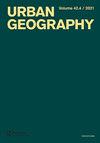退役监狱的定居城市地理:一次讨论邀请
IF 2.9
2区 经济学
Q1 GEOGRAPHY
引用次数: 0
摘要
随着城市殖民监狱逐渐过时,城市必须考虑到它们在不断发展的景观中的持久存在。在考察退役监狱如何被纳入移民殖民城市的城市发展议程时,我认为城市监狱的遗产化是掠夺性的;它通过将废弃的carceral遗址与所谓的“后”carceral城市并置来捕捉和操纵时间。这一举措对这座城市来说是有利可图的,首先因为它从独特的“文化遗产”遗址中产生了“垄断租金”,其次因为它“解放”了城市土地——现在已经从过去的混乱中清理出来——供资本主义投资。与此相反,本文断言,残酷是移民殖民城市的一种生活结构。在这些城市,种族资本主义一直与针对土著人的惩罚和剥削措施交织在一起,土著人在澳大利亚监狱中的比例仍然空前过高。本文章由计算机程序翻译,如有差异,请以英文原文为准。
Settler urban geographies of decommissioned prisons: an invitation to a discussion
ABSTRACT As urban colonial prisons are becoming obsolete, cities must reckon with their enduring presence in landscapes that are continuously developing. Examining how decommissioned prisons are placed within urban development agendas in settler colonial cities, I consider the heritagisation of urban prisons as extractive; it captures and manipulates time through the juxtaposition of defunct carceral sites with the so-called “post” carceral city. This move is profitable for the city first since it generates “monopoly rent” from unique “cultural heritage” sites, and second since it “frees” urban land – now cleaned from its carceral past – for capitalist investment. Against this, the paper asserts that carcerality is a living structure of settler colonial cities. In these cities, racial capitalism has always been intertwined with punitive and extractive measures against Indigenous people, who remain unprecedently overrepresented in Australian prisons.
求助全文
通过发布文献求助,成功后即可免费获取论文全文。
去求助
来源期刊

Urban Geography
Multiple-
CiteScore
7.60
自引率
10.50%
发文量
104
期刊介绍:
Editorial Policy. Urban Geography publishes research articles covering a wide range of topics and approaches of interest to urban geographers. Articles should be relevant, timely, and well-designed, should have broad significance, and should demonstrate originality.
 求助内容:
求助内容: 应助结果提醒方式:
应助结果提醒方式:


